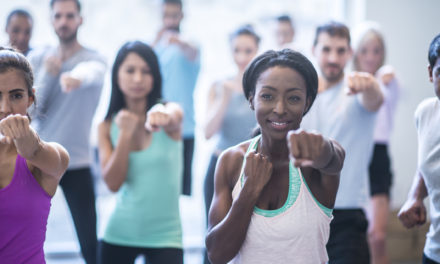In recent years, we’ve seen too many frightening examples of violence against women, including high-profile incidents of domestic violence in the NFL and scathing reports of sexual misconduct and rape in the military and on college campuses across the country.
These are stark reminders that women can find themselves too often in situations where they need to protect themselves. Or, at a minimum, they need an escape plan to get away from a potentially violent situation. People tend to think of self-defense as kicks, punches, and uppercuts, but, unlike martial arts, learning to fight isn’t the objective of most self-defense courses. Self-defense moves are designed to extricate you from an offender’s grip or distract an attacker so you can get away, says Phil Migliarese, a 5th-degree Gracie Brazilian Jiu-Jitsu black belt, and owner of Balance Studios in Philadelphia.
“Self-defense does not mean self-offense, because it’s completely unrealistic for someone who is smaller to go up against someone much bigger. The weight of the average predator is 160, according to FBI data,” says Migliarese, who has taught self-defense to thousands of women, including law enforcement officials, over the past 25 years through his Easy Escape self-defense program. Easy Escape utilizes Gracie Jiu-Jitsu, gentle movements designed for weaker opponents to defend against stronger ones.
Empowering Young Women
More than 75 percent of female victims were raped or sexually assaulted before age 25, according to the latest National Intimate Partner and Sexual Violence survey. One of the most dangerous times for a young woman is her first year of college, especially from September through Thanksgiving, according to Rape Aggression Defense, a self-defense program taught at many college campuses nationwide. An estimated one in five young women will be the victim of sexual assault while she is in college.
Self-defense training gives young women the confidence and skill set they need to thwart unwanted advances, found a 2013 study by University of Oregon sociologist Jocelyn Hollander. In her study, college women who took a 10-week women’s self-defense course reported fewer incidences of unwanted sexual contact 1 year after taking the course than female students in the study who had not taken the course, 12 percent versus 30 percent. Most comprehensive self-defense training courses last several weeks. Balance Studio’s Easy Escape program lasts 8 weeks.
If time or money is a factor, the National Self-Defense Institute offers a 2-hour class for teen and adult women through local community centers, corporate offices, and faith-based groups. NSDI’s S.A.F.E. program emphasizes situational awareness, risk reduction, and avoiding confrontation, and provides a starting point for physical self-defense.
What to Look For
A multi-week self-defense program helps women reinforce tactics they learn. “Your body has to memorize the moves to do them effectively,” says Migliarese. Whichever program you choose, look for qualified instructors and a program that emphasizes escaping your attackers, not engaging them.
The first thing any self-defense program should teach is awareness, says Migliarese. “Self-defense is a lifelong study,” he says. “It’s a misconception to think some sort of martial art will solve all your problems—it won’t.”
Self-defense training has limits, and sometimes women need to make a gut decision depending on the situation, says Jennifer Lawler, a 2nd-degree black belt in Tae Kwan Do and author of The Self-Defense Deck: 50 Powerful Strategies for Staying Safe. “It’s okay to surrender. No one has the right to judge how you respond to a threat,” says Lawler. “In the moment, it may seem safer to just do what the attacker demands.”
Decide what’s worth defending, says Lawler, who is also a self-defense instructor. “If a mugger grabs your purse, it’s not worth risking physical harm to prevent it from being stolen. If someone threatens to physically hurt you, that may be another story.”
Not Just Stranger Danger
While most women fear being attacked by an unknown assailant, the majority of violence against women comes at the hands of someone they know. Twenty-five percent of female rape and sexual assault victims were assaulted by a stranger, versus 48 percent by friends, family members, and acquaintances, and 17 percent by intimate partners, according to the 2010 National Crime Victimization Survey. For female homicides, only 12 percent were committed by strangers.
A good self-defense class also teaches women how to spot potential abusive relationships before they start and how to get out of one safely before it’s too late. “It is most likely that an attack that harms you is going to come from someone you know, and you have to be mentally and physically prepared for your own safety, to protect yourself at any time,” says Debby Tucker, executive director of the National Center on Domestic & Sexual Violence based in Austin, Texas, who recommends all women take self-defense training.
While Tucker says she wishes we could get to the root of the problem—changing the mindset of people who think it’s acceptable to use violence—she knows women need to be able to protect themselves in the now. “We have to be prepared and think through the strategies we might use in any situation, whether it’s in our own home or on the street.”






